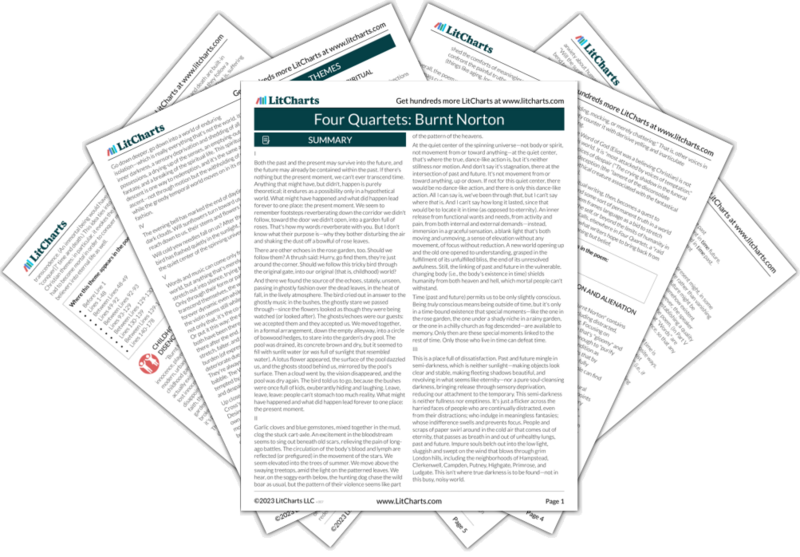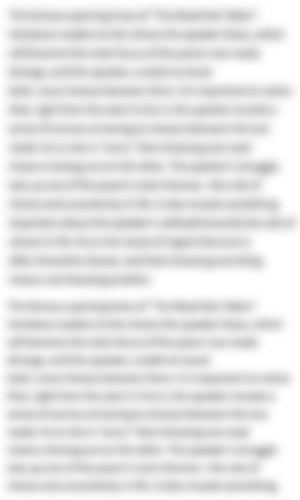
"Burnt Norton" is the opening poem of T. S. Eliot's book-length sequence Four Quartets. The poem was first published in 1936, and the Quartets as a whole appeared in book form in 1943. In "Burnt Norton," which takes its title from a decaying English country estate, the speaker meditates on the intersection of past, present, and future—and on the idea of transcending time altogether, as if occupying "the still point of the turning world." Over the course of five sections, the poem juxtaposes images of a "rose-garden" (which evoke a mythical childhood paradise) with "gloomy" images of Eliot's London (which capture the "distraction" and "disaffection" of modern life). Rather than accept this gloom as inevitable, the speaker seeks—and urges the reader toward—a vision of recaptured innocence and purity. Together, the Four Quartets (which consist of this poem, "East Coker," "The Dry Salvages," and "Little Gidding") are widely considered the definitive statement of Eliot's religious beliefs and philosophical ideas.
|
Get
LitCharts
|

|
The Full Text of “Four Quartets: Burnt Norton”
The Full Text of “Four Quartets: Burnt Norton”
-
“Four Quartets: Burnt Norton” Summary
-
-
“Four Quartets: Burnt Norton” Themes
-

Time, Change, and Spiritual Transcendence
Where this theme appears in the poem:- Before Line 1
- Lines 1-48
- Between Lines 48-49
- Lines 49-92
- Between Lines 92-93
- Lines 93-129
- Between Lines 129-130
- Lines 130-139
- Between Lines 139-140
- Lines 140-178
-

Childhood Innocence, Disenchantment, and Redemption
Where this theme appears in the poem:- Lines 11-18
- Lines 19-48
- Lines 49-63
- Lines 162-178
-

Escapism, Fantasy, and Distraction
Where this theme appears in the poem:- Lines 19-45
- Lines 93-129
-

Language and Belief
Where this theme appears in the poem:- Lines 11-18
- Lines 140-161
-

The Fragmentation and Alienation of Modern Life
Where this theme appears in the poem:- Lines 49-63
- Lines 93-129
- Lines 130-139
-
-
Line-by-Line Explanation & Analysis of “Four Quartets: Burnt Norton”
-
Lines 1-5
Time present and ...
... time is unredeemable. -
Lines 6-10
What might have ...
... is always present. -
Lines 11-18
Footfalls echo in ...
... do not know. -
Lines 19-24
...
... our first world. -
Lines 25-31
There they were, ...
... are looked at. -
Lines 32-36
There they were ...
... concrete, brown edged, -
Lines 37-41
And the pool ...
... pool was empty. -
Lines 42-48
Go, said the ...
... is always present. -
Lines 49-53
Garlic and sapphires ...
... long forgotten wars. -
Lines 54-59
The dance along ...
... the figured leaf -
Lines 60-63
And hear upon ...
... among the stars. -
Lines 64-69
At the still ...
... only the dance. -
Lines 70-74
I can only ...
... the outer compulsion, -
Lines 74-80
yet surrounded ...
... its partial horror. -
Lines 81-86
Yet the enchainment ...
... a little consciousness. -
Lines 87-92
To be conscious ...
... time is conquered. -
Lines 93-102
Here is a ...
... plenitude nor vacancy. -
Lines 102-106
Only a flicker ...
... with no concentration -
Lines 107-112
Men and bits ...
... the faded air, -
Lines 112-116
the torpid ...
... this twittering world. -
Lines 117-124
Descend ...
... world of spirit; -
Lines 125-129
This is the ...
... and time future. -
Lines 130-134
Time and the ...
... Clutch and cling? -
Lines 135-139
Chill ...
... the turning world. -
Lines 140-146
Words move, music ...
... in its stillness. -
Lines 147-152
Not the stillness ...
... is always now. -
Lines 152-158
Words strain, ...
... Always assail them. -
Lines 158-161
The Word in ...
... the disconsolate chimera. -
Lines 162-165
The ...
... in itself desirable; -
Lines 166-171
Love is itself ...
... un-being and being. -
Lines 172-178
Sudden in a ...
... before and after.
-
-
“Four Quartets: Burnt Norton” Symbols
-

The Rose-Garden
Where this symbol appears in the poem:- Lines 13-14: “Towards the door we never opened / Into the rose-garden.”
- Lines 19-24: “Other echoes / Inhabit the garden. Shall we follow? / Quick, said the bird, find them, find them, / Round the corner. Through the first gate, / Into our first world, shall we follow / The deception of the thrush? Into our first world.”
- Line 88: “But only in time can the moment in the rose-garden,”
-

The Lotos and the Pool
Where this symbol appears in the poem:- Lines 35-40: “To look down into the drained pool. / Dry the pool, dry concrete, brown edged, / And the pool was filled with water out of sunlight, / And the lotos rose, quietly, quietly, / The surface glittered out of heart of light, / And they were behind us, reflected in the pool.”
-

Garlic and Sapphires
Where this symbol appears in the poem:- Lines 49-50: “Garlic and sapphires in the mud / Clot the bedded axle-tree.”
-

The Stars
Where this symbol appears in the poem:- Lines 54-56: “The dance along the artery / The circulation of the lymph / Are figured in the drift of stars”
- Lines 61-63: “Below, the boarhound and the boar / Pursue their pattern as before / But reconciled among the stars.”
-
-
“Four Quartets: Burnt Norton” Poetic Devices & Figurative Language
-
Allusion
Where allusion appears in the poem:- Lines 1-5: “Time present and time past / Are both perhaps present in time future, / And time future contained in time past. / If all time is eternally present / All time is unredeemable.”
- Lines 22-24: “Through the first gate, / Into our first world, shall we follow / The deception of the thrush?”
- Line 29: “The unheard music hidden in the shrubbery,”
- Line 38: “And the lotos rose, quietly, quietly,”
- Lines 49-50: “Garlic and sapphires in the mud / Clot the bedded axle-tree.”
- Lines 145-146: “The stillness, as a Chinese jar still / Moves perpetually in its stillness.”
- Lines 158-161: “The Word in the desert / Is most attacked by voices of temptation, / The crying shadow in the funeral dance, / The loud lament of the disconsolate chimera.”
- Lines 162-163: “ The detail of the pattern is movement, / As in the figure of the ten stairs.”
-
Repetition
Where repetition appears in the poem:- Line 1: “Time present,” “time past”
- Line 2: “present,” “time future”
- Line 3: “time future,” “time past”
- Line 4: “all time,” “present”
- Line 5: “All time”
- Line 6: “What might have been”
- Lines 9-10: “What might have been and what has been / Point to one end, which is always present.”
- Line 14: “the rose-garden”
- Line 17: “rose”
- Line 20: “garden,” “Shall we follow?”
- Line 21: “the bird,” “find them, find them,”
- Line 23: “Into our first world,,” “shall we follow”
- Line 24: “Into our first world.”
- Line 28: “the bird”
- Line 30: “roses”
- Line 31: “look,” “looked”
- Line 32: “accepted,” “accepting”
- Line 34: “empty”
- Line 35: “pool”
- Line 36: “Dry,” “the pool,” “dry”
- Line 37: “the pool”
- Line 38: “quietly,” “quietly”
- Line 40: “the pool”
- Line 41: “the pool,” “empty”
- Line 42: “Go, said the bird,”
- Line 44: “Go, go, go, said the bird:”
- Line 46: “Time past and time future”
- Lines 47-48: “What might have been and what has been / Point to one end, which is always present.”
- Line 50: “tree”
- Line 54: “The”
- Line 55: “The”
- Line 56: “stars”
- Line 57: “tree”
- Line 58: “move,” “moving,” “tree”
- Line 63: “stars”
- Line 64: “At the still point of the turning world.,” “Neither,” “flesh,” “fleshless”
- Line 65: “Neither,” “from nor towards,” “the dance”
- Line 66: “neither,” “movement”
- Line 67: “past,” “future,” “Neither,” “movement,” “from nor towards”
- Line 68: “point,” “the still point”
- Line 69: “dance,” “the dance”
- Line 70: “say,” “say”
- Line 71: “say,” “time”
- Line 72: “The,” “from”
- Line 73: “The,” “release,” “from,” “release,” “from”
- Line 75: “light,” “still,” “moving”
- Line 76: “without”
- Line 77: “Without”
- Line 79: “the,” “of its partial”
- Line 80: “The,” “of its partial”
- Line 81: “past,” “future”
- Line 84: “flesh”
- Line 85: “Time past and time future”
- Line 86: “consciousness”
- Line 87: “conscious,” “in time”
- Line 88: “in time,” “moment in the,” “rose-garden”
- Line 89: “The moment in the”
- Line 90: “The moment in the”
- Line 91: “past,” “future”
- Line 92: “time time”
- Line 94: “Time before and time after”
- Line 103: “time”
- Line 104: “Distracted,” “distraction,” “distraction”
- Line 108: “before and after,” “time”
- Line 110: “Time before and time after.”
- Line 116: “world”
- Line 117: “Descend,” “descend”
- Line 118: “world”
- Line 119: “World,” “not world,” “not world”
- Line 122: “of the world of”
- Line 123: “of the world of”
- Line 124: “of the world of”
- Line 126: “movement”
- Line 127: “movement,” “the world,” “moves”
- Line 129: “time past and time future.”
- Line 130: “Time”
- Line 132: “to us”
- Line 133: “to us”
- Line 138: “light,” “light,” “light,” “still”
- Line 139: “At the still point of the turning world.”
- Line 140: “Words,” “move,” “music,” “moves”
- Line 141: “Only,” “time,” “only”
- Line 142: “only,” “Words”
- Line 143: “Only”
- Line 144: “words,” “music”
- Line 145: “stillness,” “still”
- Line 146: “stillness”
- Line 147: “stillness”
- Line 148: “only”
- Line 149: “the end,” “the beginning”
- Line 150: “the end,” “the beginning,” “always”
- Line 151: “Before,” “the beginning,” “after,” “the end”
- Line 152: “always,” “Words”
- Line 155: “will not stay”
- Line 156: “Will not stay”
- Line 160: “The”
- Line 161: “The”
- Line 162: “movement”
- Line 164: “itself,” “movement”
- Line 165: “itself”
- Line 166: “itself”
- Line 167: “movement”
- Line 168: “Timeless”
- Line 169: “time”
- Line 171: “being,” “being”
- Line 178: “before,” “after”
-
Juxtaposition
Where juxtaposition appears in the poem:- Lines 1-18: “Time present and time past / Are both perhaps present in time future, / And time future contained in time past. / If all time is eternally present / All time is unredeemable. / What might have been is an abstraction / Remaining a perpetual possibility / Only in a world of speculation. / What might have been and what has been / Point to one end, which is always present. / Footfalls echo in the memory / Down the passage which we did not take / Towards the door we never opened / Into the rose-garden. My words echo / Thus, in your mind. / But to what purpose / Disturbing the dust on a bowl of rose-leaves / I do not know.”
- Lines 49-63: “Garlic and sapphires in the mud / Clot the bedded axle-tree. / The trilling wire in the blood / Sings below inveterate scars / Appeasing long forgotten wars. / The dance along the artery / The circulation of the lymph / Are figured in the drift of stars / Ascend to summer in the tree / We move above the moving tree / In light upon the figured leaf / And hear upon the sodden floor / Below, the boarhound and the boar / Pursue their pattern as before / But reconciled among the stars.”
- Lines 88-91: “But only in time can the moment in the rose-garden, / The moment in the arbour where the rain beat, / The moment in the draughty church at smokefall / Be remembered;”
- Lines 93-129: “Here is a place of disaffection / Time before and time after / In a dim light: neither daylight / Investing form with lucid stillness / Turning shadow into transient beauty / With slow rotation suggesting permanence / Nor darkness to purify the soul / Emptying the sensual with deprivation / Cleansing affection from the temporal. / Neither plenitude nor vacancy. Only a flicker / Over the strained time-ridden faces / Distracted from distraction by distraction / Filled with fancies and empty of meaning / Tumid apathy with no concentration / Men and bits of paper, whirled by the cold wind / That blows before and after time, / Wind in and out of unwholesome lungs / Time before and time after. / Eructation of unhealthy souls / Into the faded air, the torpid / Driven on the wind that sweeps the gloomy hills of London, / Hampstead and Clerkenwell, Campden and Putney, / Highgate, Primrose and Ludgate. Not here / Not here the darkness, in this twittering world. / Descend lower, descend only / Into the world of perpetual solitude, / World not world, but that which is not world, / Internal darkness, deprivation / And destitution of all property, / Desiccation of the world of sense, / Evacuation of the world of fancy, / Inoperancy of the world of spirit; / This is the one way, and the other / Is the same, not in movement / But abstention from movement; while the world moves / In appetency, on its metalled ways / Of time past and time future.”
- Lines 130-139: “Time and the bell have buried the day, / The black cloud carries the sun away. / Will the sunflower turn to us, will the clematis / Stray down, bend to us; tendril and spray / Clutch and cling? / Chill / Fingers of yew be curled / Down on us? After the kingfisher's wing / Has answered light to light, and is silent, the light is still / At the still point of the turning world.”
- Lines 162-178: “ The detail of the pattern is movement, / As in the figure of the ten stairs. / Desire itself is movement / Not in itself desirable; / Love is itself unmoving, / Only the cause and end of movement, / Timeless, and undesiring / Except in the aspect of time / Caught in the form of limitation / Between un-being and being. / Sudden in a shaft of sunlight / Even while the dust moves / There rises the hidden laughter / Of children in the foliage / Quick now, here, now, always— / Ridiculous the waste sad time / Stretching before and after.”
-
Paradox
Where paradox appears in the poem:- Lines 1-3: “Time present and time past / Are both perhaps present in time future, / And time future contained in time past.”
- Lines 46-48: “Time past and time future / What might have been and what has been / Point to one end, which is always present.”
- Lines 66-67: “But neither arrest nor movement. And do not call it fixity, / Where past and future are gathered.”
- Lines 70-71: “I can only say, / there / we have been: but I cannot say where. / And I cannot say, how long, for that is to place it in time.”
- Line 75: “a white light still and moving,”
- Lines 76-76: “Erhebung / without motion,”
- Line 92: “Only through time time is conquered.”
- Line 119: “World not world, but that which is not world,”
- Lines 125-126: “This is the one way, and the other / Is the same,”
- Lines 145-146: “as a Chinese jar still / Moves perpetually in its stillness.”
- Lines 149-152: “Or say that the end precedes the beginning, / And the end and the beginning were always there / Before the beginning and after the end. / And all is always now.”
- Lines 168-171: “Timeless, and undesiring / Except in the aspect of time / Caught in the form of limitation / Between un-being and being.”
-
Antithesis
Where antithesis appears in the poem:- Line 1: “Time present and time past”
- Line 3: “And time future contained in time past.”
- Line 9: “What might have been and what has been”
- Lines 46-47: “Time past and time future / What might have been and what has been”
- Line 61: “Below, the boarhound and the boar”
- Lines 64-65: “Neither flesh nor fleshless; / Neither from nor towards;”
- Line 66: “But neither arrest nor movement.”
- Lines 67-68: “Where past and future are gathered. Neither movement from nor towards, / Neither ascent nor decline.”
- Line 69: “There would be no dance, and there is only the dance.”
- Lines 73-74: “release from the inner / And the outer compulsion,”
- Line 75: “a white light still and moving,”
- Lines 77-78: “both a new world / And the old made explicit,”
- Lines 79-80: “the completion of its partial ecstasy, / The resolution of its partial horror.”
- Line 81: “Yet the enchainment of past and future”
- Line 83: “Protects mankind from heaven and damnation”
- Line 85: “Time past and time future”
- Line 94: “Time before and time after”
- Line 95: “neither daylight”
- Line 99: “Nor darkness”
- Line 102: “Neither plenitude nor vacancy.”
- Line 108: “That blows before and after time,”
- Lines 109-110: “Wind in and out of unwholesome lungs / Time before and time after.”
- Lines 125-127: “This is the one way, and the other / Is the same, not in movement / But abstention from movement;”
- Line 129: “Of time past and time future.”
- Lines 141-142: “but that which is only living / Can only die.”
- Lines 142-143: “Words, after speech, reach / Into the silence.”
- Lines 144-145: “Can words or music reach / The stillness,”
- Line 149: “the end precedes the beginning,”
- Line 150: “the end and the beginning”
- Line 151: “Before the beginning and after the end.”
- Lines 166-167: “Love is itself unmoving, / Only the cause and end of movement,”
- Line 171: “Between un-being and being.”
-
Diacope
Where diacope appears in the poem:- Line 1: “Time present,” “time”
- Line 2: “present,” “time future”
- Line 3: “time future,” “time past”
- Line 4: “all time,” “present”
- Line 5: “All time”
- Line 23: “Into our first world”
- Line 24: “Into our first world”
- Line 31: “look,” “looked”
- Line 32: “accepted,” “accepting”
- Line 35: “pool”
- Line 36: “Dry,” “the pool,” “dry”
- Line 37: “the pool”
- Line 40: “the pool”
- Line 41: “the pool”
- Line 58: “move,” “moving”
- Line 68: “point,” “point”
- Line 69: “dance,” “dance”
- Line 85: “Time,” “time”
- Line 87: “in time”
- Line 88: “in time”
- Line 95: “light,” “daylight”
- Line 104: “Distracted,” “distraction,” “distraction”
- Line 108: “before,” “after time”
- Line 110: “Time before,” “time after”
- Line 117: “Descend,” “descend”
- Line 118: “world”
- Line 119: “World not world,” “not world”
- Line 126: “movement”
- Line 127: “movement,” “moves”
- Line 138: “light,” “light,” “light”
- Line 140: “Words move,” “music moves”
- Line 141: “Only,” “only”
- Line 142: “only,” “Words,” “reach”
- Line 143: “Only”
- Line 144: “words,” “music,” “reach”
- Line 145: “The stillness,” “still”
- Line 146: “stillness”
- Line 147: “the stillness”
- Line 149: “the end,” “the beginning”
- Line 150: “the end,” “the beginning,” “always”
- Line 151: “the beginning,” “the end”
- Line 152: “always”
- Line 155: “will not stay”
- Line 156: “Will not stay”
- Line 162: “movement”
- Line 164: “Desire,” “itself,” “movement”
- Line 165: “itself”
- Line 166: “itself,” “unmoving”
- Line 167: “movement”
- Line 168: “Timeless,” “undesiring”
- Line 169: “time”
-
-
“Four Quartets: Burnt Norton” Vocabulary
Select any word below to get its definition in the context of the poem. The words are listed in the order in which they appear in the poem.
- Unredeemable
- Abstraction
- Footfalls
- Thrush
- Box circle
- Lotos
- Heart of light
- Clot
- Axle-tree
- Trilling
- Inveterate
- Appeasing
- The lymph
- Figured
- Boarhound
- Fixity
- Erhebung
- Enchainment
- Arbour
- Smokefall
- Disaffection
- The temporal
- Plenitude
- Time-ridden
- Tumid
- Eructation
- Torpid
- Hampstead, Clerkenwell, Campden, Putney, Highgate, Primrose, Ludgate
- Twittering
- Destitution
- Dessication
- Evacuation
- Inoperancy
- Abstention
- Appetency
- Clematis
- Tendril and spray
- Yew
- Kingfisher
- Chinese jar
- Assail
- The Word in the desert
- Disconsolate
- Chimera
- Figure of the ten stairs
- Waste
-
(Location in poem: Line 5: “All time is unredeemable.”)
-
Form, Meter, & Rhyme Scheme of “Four Quartets: Burnt Norton”
-
Form
-
Meter
-
Rhyme Scheme
-
-
“Four Quartets: Burnt Norton” Speaker
-
-
“Four Quartets: Burnt Norton” Setting
-
-
Literary and Historical Context of “Four Quartets: Burnt Norton”
-
-
More “Four Quartets: Burnt Norton” Resources
-
External Resources
-
The Poem Aloud — Listen to T. S. Eliot read "Burnt Norton."
-
Another Reading — Actor Ralph Fiennes reads the poem aloud.
-
A T. S. Eliot Documentary — Watch a BBC film about the life and career of the poet.
-
The Poet's Life — A short biography of T. S. Eliot at the Poetry Foundation.
-
Modernism: An Introduction — An overview of the literary movement that Eliot helped define.
-
Eliot's New York Times Obituary — How Eliot was remembered by fellow poets and critics at the time of his death in 1965.
-
-
LitCharts on Other Poems by T. S. Eliot
-















